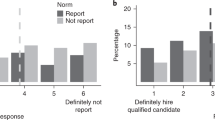Abstract
Norm regulation was examined in 18 outpatient psychotherapy groups, each led by cotherapists and varying in size from two to eight clients. Clients indicated acceptabilityand likelihood of occurrenceof 24 member behaviors. Positive norm regulation of acceptable behaviors was more readily achieved than negative norm regulation of unacceptable behaviors. The amount of positive regulation in any group was unrelated to the amount of negative regulation. However, group size was associated with both positive and negative regulation, with very small groups achieving more norm regulations than large groups.
Similar content being viewed by others
References
BALES, R. F. The equilibrium problem in small groups. In T. Parsons, R. F. Bales, & E. A. Shils (Eds.),Working Papers in the Theory of Action. New York: Free Press, 1953, pp. 111–161.
BALES, R. F.Personality and Interpersonal Behavior. New York: Holt, Rinehart & Winston, 1970.
BECK, A. P., DUGO, J. M., ENG, A. M., LEWIS, C. M. & PETERS, L. N. The participation of leaders in the structural development of therapy groups. In R. R. Dies & K. R. MacKenzie (Eds.),Advances in Group Psychotherapy: Integrating Research and Practice. Monograph 1, American Group Psychotherapy Association Monograph Series. New York: International Universities Press, 1983, pp. 137–158.
BOND, G. R. Norm regulation in therapy groups. In R. R. Dies & K. R. MacKenzie (Eds.),Advances in Group Psychotherapy: Integrating Research and Practice. Monograph 1, American Group Psychotherapy Association Monograph Series. New York: International Universities Press, 1983, pp. 171–189.
CANCIAN, F. What are norms? A study of beliefs and action in a Maya community. Unpublished manuscript, Stanford University, Department of Sociology, 1972.
DIES, R. R. Bridging the gap between research and practice in group psychotherapy. In R. R. Dies & K. R. MacKenzie (Eds.),Advances in Group Psychotherapy: Integrating Research and Practice. Monograph 1, American Group Psychotherapy Association Monograph Series. New York: International Universities Press, 1983, pp. 1–26.
HOMANS, G. C.Social Behavior: Its Elementary Forms. New York: Harcourt, Brace & World, 1961.
LEVINE, B.Group Psychotherapy: Practice and Development. Englewood Cliffs, NJ: Prentice-Hall, 1979.
LIEBERMAN, M. A., YALOM, I. D. & MILES, M. B.Encounter Groups: First Facts. New York: Basic Books, 1973.
MacKENZIE, K. R. Group norms: Importance and measurement.International Journal of Group Psychotherapy, 1979, 29, 471–480.
TUCKMAN, B. W. Developmental sequence in small groups.Psychological Bulletin, 1965, 63, 384–399.
WHITAKER, D. S. & LIEBERMAN, M. A.Psychotherapy through the Group Process. New York: Atherton, 1964.
YALOM, I. D.The Theory and Practice of Group Psychotherapy. New York: Basic Books, 1975.
YALOM, I. D., BLOCK, S., BOND, G. R., ZIMMERMAN, E. & QUALLS, B. Alcoholics in interactional group therapy.Archives of General Psychiatry, 1978, 35, 419–425.
Author information
Authors and Affiliations
Additional information
The author is grateful to suggestions by Bob Dies, Ken Howard, and Roy MacKenzie on an earlier draft of this paper.
Rights and permissions
About this article
Cite this article
Bond, G.R. Positive and negative norm regulation and their relationship to therapy group size. Group 8, 35–44 (1984). https://doi.org/10.1007/BF01456557
Issue Date:
DOI: https://doi.org/10.1007/BF01456557




